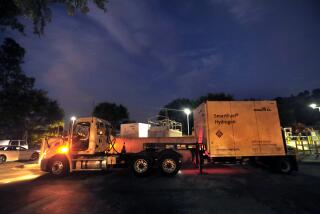Hydrogen Cars Are Step Closer
- Share via
WASHINGTON — Researchers say they have moved a step closer to a cost-effective way to power automobiles with only sunlight and water.
The technology behind a solar-hydrogen-powered car has been known for years, but commercial development remains unrealistic, in part because of the high cost of using solar power to produce the hydrogen from water.
But two scientists at the federal National Renewable Energy Laboratory in Golden, Colo., have developed a one-step device that uses solar power to convert water into a hydrogen fuel.
This could substantially reduce the cost of using solar power to split water into hydrogen and oxygen molecules, a process known as electrolysis, said John Turner, a chemist at the laboratory, who outlined his research in Friday’s issue of Science magazine.
In an interview, Turner said it likely will take years of research and a greater political and economic commitment for solar-hydrogen fuel to become commercially acceptable.
This newest development “isn’t the magic bullet that gets us there” but is a “nice scientific accomplishment” that shows that solar power can be used to split water into hydrogen and oxygen at a cheaper cost and with less energy loss.
A series of technological breakthroughs in recent years has renewed sharp interest among auto makers in hydrogen fuel cells as the eventual replacement for the internal combustion engine. Car manufacturers predict thousands of hydrogen fuel cell vehicles will be available at competitive prices as early as 2004.
But these cars are expected to use hydrogen taken from fossil sources such as natural gas or methanol. About 90% of the hydrogen used for industrial and other purposes comes from natural gas.
*
Turner says, however, that eventually the most environmentally sound approach would be to use solar power to take hydrogen from water. The only waste produced would be water. That already is being done experimentally, but it uses an expensive and less efficient two-step process--one step producing a photovoltaic electrical charge and the second step splitting the water molecules with the electrical charge.
Turner, working with an associate, Oscar Khaselev, combined the two steps into one, although in the past the two processes have been found not to be very compatible.
The one-step process converts about 12% of the solar-produced energy, or twice the efficiency, of the two-step process, said Turner. And the cost of producing hydrogen also is reduced to about one-fourth of what it is in the two-step process.
Still, the process is “three or four times as expensive” as the steam method used for getting hydrogen from natural gas, he acknowledged.
But hydrogen fuel cell advocates say such a cost reduction in solar-hydrogen fuel technology is significant.
“The bottom line is cost,” said Sandy Thomas, a vice president of Directed Technologies Inc. of Arlington, Va., which has been a technical consultant on hydrogen fuel cells to both the Energy Department and Ford Motor Co.
Getting hydrogen from natural gas is now the cheapest way to make it, said Thomas, and it would be good news if the costs of using solar power and water were in the range outlined by Turner. “That would be a real boost for the environment.”






